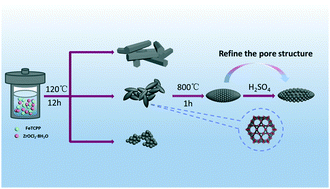当前位置:
X-MOL 学术
›
Catal. Sci. Technol.
›
论文详情
Our official English website, www.x-mol.net, welcomes your
feedback! (Note: you will need to create a separate account there.)
Hierarchically porous Fe–N–C nanospindles derived from a porphyrinic coordination network for oxygen reduction reaction†
Catalysis Science & Technology ( IF 4.4 ) Pub Date : 2018-03-02 00:00:00 , DOI: 10.1039/c8cy00168e Xing Hua 1, 2, 3, 4, 5 , Jin Luo 1, 2, 3, 4, 5 , Chencheng Shen 1, 2, 3, 4, 5 , Shengli Chen 1, 2, 3, 4, 5
Catalysis Science & Technology ( IF 4.4 ) Pub Date : 2018-03-02 00:00:00 , DOI: 10.1039/c8cy00168e Xing Hua 1, 2, 3, 4, 5 , Jin Luo 1, 2, 3, 4, 5 , Chencheng Shen 1, 2, 3, 4, 5 , Shengli Chen 1, 2, 3, 4, 5
Affiliation

|
We report the size and morphology-controlled synthesis of PCN-222 crystals, a class of zirconium-based iron porphyrinic coordination networks, and their pyrolytic derivation of hierarchically porous Fe–N–C electrocatalysts for the oxygen reduction reaction (ORR). By optimizing precursor concentrations, nanometer-scaled and spindle-shaped PCN-222 crystals are obtained through a solvothermal method. A NaCl salt-assisted pyrolysis is employed to convert the PCN-222 crystals to an Fe–N–C catalyst, so as to inherit the nanospindle morphology and the Fe–N coordination structure in the PCN precursor, and at the same time to increase the graphitization degree. A post-activation procedure using concentrated sulfuric acid is further designed to induce a controlled NaCl removal and carbon etching process that optimizes the porous structures and surface properties of the final nanospindle Fe–N–C catalyst. The reaction between the concentrated sulfuric acid and NaCl produces heat to activate acid etching of carbon, and on the other hand consumes the acid to prevent the carbon from over-etching. The unique nanospindle shape and hierarchically porous structure allow efficient exposure of the high-density active sites and their accessibility to reactants, while the high degree of graphitization ensures efficient conduction of electrons involved in the electrocatalytic reaction and good stability of the carbon matrix during the electrocatalytic processes. Based on the results, the as-prepared Fe–N–C catalyst exhibits remarkable ORR performance, with a half-wave potential that is ca. 30 mV more positive than that of the state-of-the-art Pt catalyst, and excellent stability in alkaline solution, as well as an ORR activity comparable to Pt in acid solution.
中文翻译:

源自卟啉配位网络的分层多孔Fe–N–C纳米纺锤,用于氧还原反应†
我们报告了PCN-222晶体的尺寸和形貌控制的合成,一类基于锆的铁卟啉配位网络,以及它们的热解衍生物,用于氧还原反应(ORR)的分级多孔Fe-N-C电催化剂。通过优化前驱物浓度,可通过溶剂热法获得纳米级和纺锤状PCN-222晶体。NaCl盐辅助热解法将PCN-222晶体转化为Fe–N–C催化剂,从而继承了PCN前体中的纳米锭形态和Fe–N配位结构,并同时增加了石墨化程度。进一步设计了使用浓硫酸的活化后程序,以诱导受控的NaCl去除和碳蚀刻过程,从而优化最终纳米锭Fe–N–C催化剂的多孔结构和表面性质。浓硫酸和氯化钠之间的反应产生热量以激活碳的酸蚀,另一方面消耗酸以防止碳过度腐蚀。独特的纳米纺锤形形状和分层多孔结构可实现高密度活性位点的有效暴露及其对反应物的可及性,而高度石墨化可确保参与电催化反应的电子有效传导,并在电催化过程中使碳基质具有良好的稳定性流程。根据结果,约。比最先进的Pt催化剂高30 mV的正离子,在碱性溶液中具有出色的稳定性,以及与酸性溶液中的Pt相当的ORR活性。
更新日期:2018-03-02
中文翻译:

源自卟啉配位网络的分层多孔Fe–N–C纳米纺锤,用于氧还原反应†
我们报告了PCN-222晶体的尺寸和形貌控制的合成,一类基于锆的铁卟啉配位网络,以及它们的热解衍生物,用于氧还原反应(ORR)的分级多孔Fe-N-C电催化剂。通过优化前驱物浓度,可通过溶剂热法获得纳米级和纺锤状PCN-222晶体。NaCl盐辅助热解法将PCN-222晶体转化为Fe–N–C催化剂,从而继承了PCN前体中的纳米锭形态和Fe–N配位结构,并同时增加了石墨化程度。进一步设计了使用浓硫酸的活化后程序,以诱导受控的NaCl去除和碳蚀刻过程,从而优化最终纳米锭Fe–N–C催化剂的多孔结构和表面性质。浓硫酸和氯化钠之间的反应产生热量以激活碳的酸蚀,另一方面消耗酸以防止碳过度腐蚀。独特的纳米纺锤形形状和分层多孔结构可实现高密度活性位点的有效暴露及其对反应物的可及性,而高度石墨化可确保参与电催化反应的电子有效传导,并在电催化过程中使碳基质具有良好的稳定性流程。根据结果,约。比最先进的Pt催化剂高30 mV的正离子,在碱性溶液中具有出色的稳定性,以及与酸性溶液中的Pt相当的ORR活性。











































 京公网安备 11010802027423号
京公网安备 11010802027423号